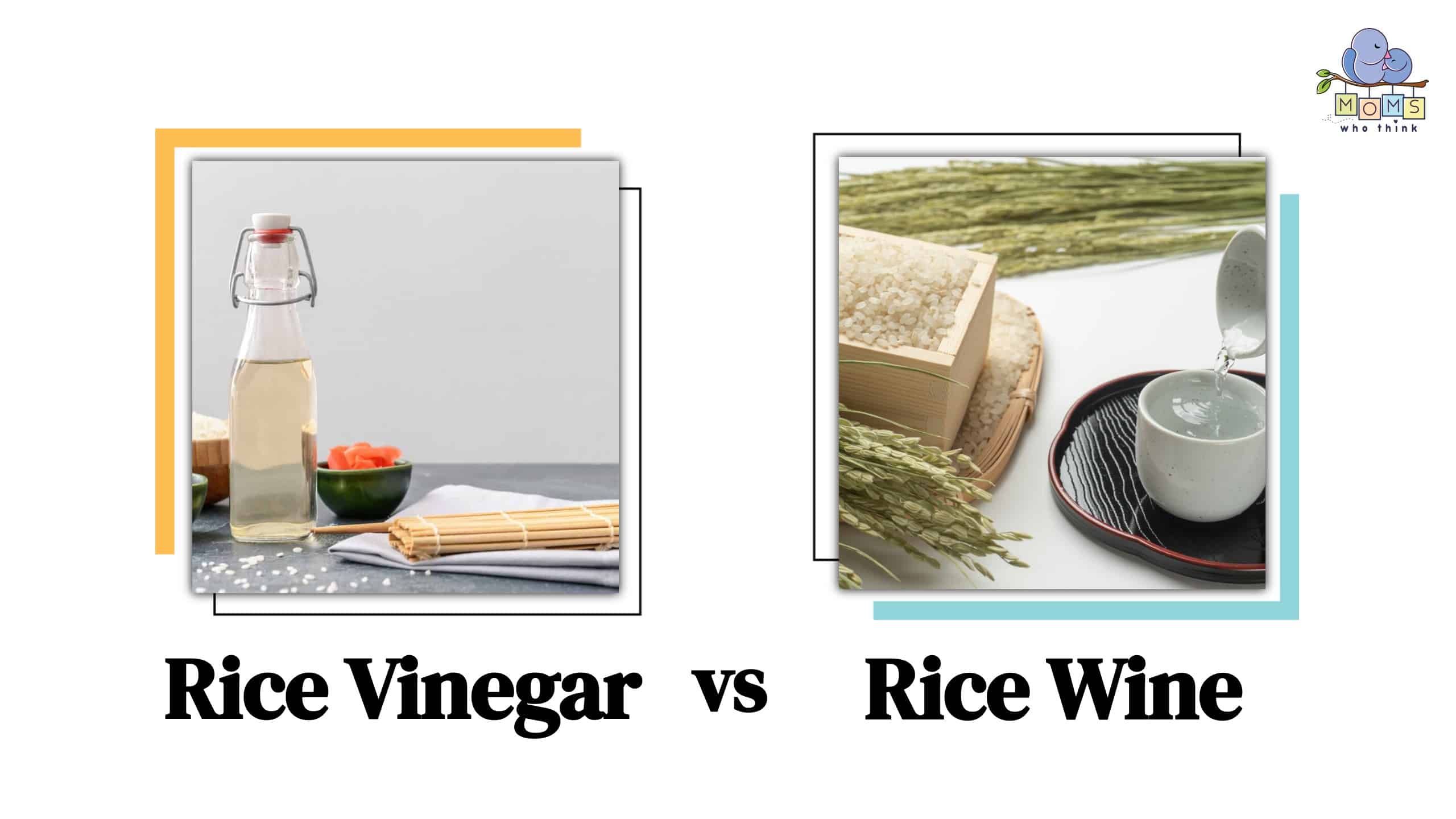If you’re familiar with Asian cuisine, you may have wondered about the difference between rice vinegar vs. rice wine. Both of these ingredients are used in Asian-inspired meals and to add to the confusion, rice vinegar is sometimes called rice wine vinegar. Despite their similar names, rice wine and rice wine vinegar are not the same.
Rice vinegar and rice wine are both made from fermented rice, but rice wine is an alcoholic beverage. Rice vinegar is non-alcoholic and is used for dishes such as sushi or fried rice. Rice wine, also known as saki, can be used for cooking or drinking.
If you’ve ever confused rice vinegar with rice wine, you’re not alone. Keep reading to find out about how they’re made and what they’re used for.
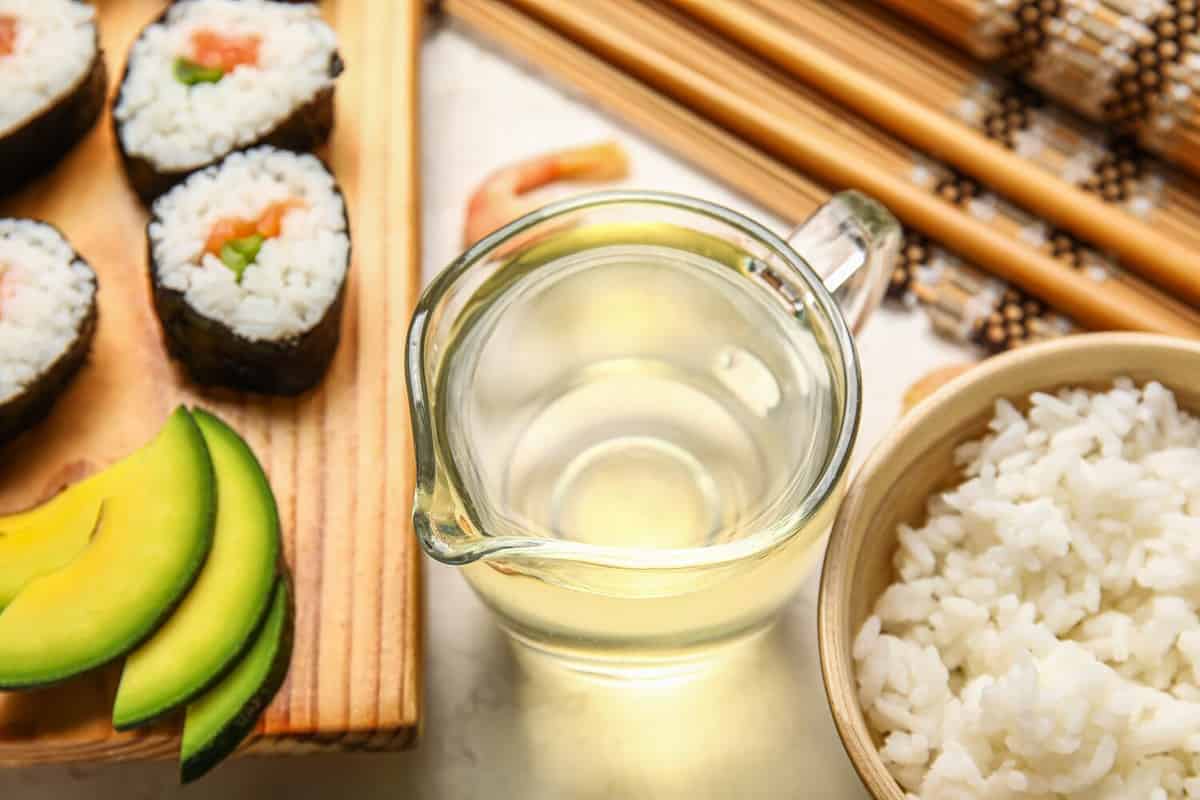
Rice vinegar is a popular type of vinegar used in Asian dishes such as sushi.
©Pixel-Shot/Shutterstock.com
Rice Vinegar vs Rice Wine: What Is the Difference?
Although many people confuse rice vinegar with rice wine, it’s important to know right off the bat that you can't use them interchangeably. Rice wine is an alcoholic beverage that you can also use for cooking.
Rice vinegar and rice wine are both made from fermented rice, but rice vinegar goes one step further in the fermentation process. Like most types of vinegar, rice vinegar is made from alcohol, but it is converted into acetic acid through a double fermentation process.
Most of the alcohol in rice vinegar is used up during the process so it’s not an alcoholic beverage like rice wine. Although there may still be a trace amount of alcohol found in vinegar, you certainly won’t find anyone enjoying a glass of rice vinegar before their meal.
Rice vinegar is sometimes called rice wine vinegar, but they’re describing the same type of vinegar. Rice vinegar is used mostly in cooking, while rice wine is a popular alcoholic beverage in many Asian countries. In Japan, the term rice wine is generally synonymous with sake, a well-known Japanese alcoholic beverage.
What is Rice Vinegar?
Rice vinegar, also known as rice wine vinegar, is made by fermenting rice and then converting the alcohol into acetic acid. During the fermentation process, the sugar in the rice is converted into alcohol, making rice wine. When the rice wine is fermented again, it becomes rice vinegar.
This type of vinegar is commonly used in cooking. You’ll find rice vinegar as an ingredient in sushi, stir-fries, and dipping sauces. It’s also great to use as a marinade or in salad dressings.
Compared to other popular vinegar types like white distilled vinegar, rice vinegar has a milder, sweeter flavor and isn’t quite as acidic. More powerful flavors like balsamic vinegar are excellent when you’re making a vinaigrette, but if you’re looking for a more subtle flavor, rice vinegar may provide the flavor you’re looking for.
Since rice vinegar is popular in several different regions, there are several variations of rice vinegar as well. Here are the most popular types of rice vinegar:
- White rice vinegar
- Brown rice vinegar
- Black rice vinegar
- Red rice vinegar
- Seasoned rice vinegar
White rice vinegar is the standard type that you’ll see in most grocery stores. However, variations such as brown rice vinegar, black rice vinegar, and red rice vinegar are the same as white rice vinegar but with different types of rice.
Seasoned rice vinegar, on the other hand, is usually rice vinegar mixed with sugar, salt, or other seasonings.
Substitutes for Rice Vinegar
When it comes to pantry staples, rice vinegar may not be something you regularly keep in your cabinet. If you’re making a new dish at home and realize you need rice vinegar but you don’t have any on hand, here are some acceptable substitutes:
Apple Cider Vinegar
Apple cider vinegar is the best substitute for rice vinegar in most cases because it has the most similar flavor. Like rice vinegar, apple cider vinegar has a slight sweetness to it. The flavor of apple cider vinegar is stronger and fruitier than rice vinegar but you can adjust the rest of your recipe if necessary to match the flavor.
Lemon or Lime Juice
When you’re in a pinch and don’t have any vinegar on hand, using an acidic juice such as lemon or lime juice can work as a substitute. Both lemon and lime juice are going to change the flavor of the dish you’re making. For this reason, they may not work well for every recipe. However, they can be great substitutes when you’re making a marinade or salad dressing.
White Vinegar
White vinegar is the type of vinegar most people keep in their cabinets, especially since it has many uses outside of the kitchen. It has a much more acidic taste than rice vinegar and lacks sweetness as well, but it will work as a substitute if it’s all you have available.
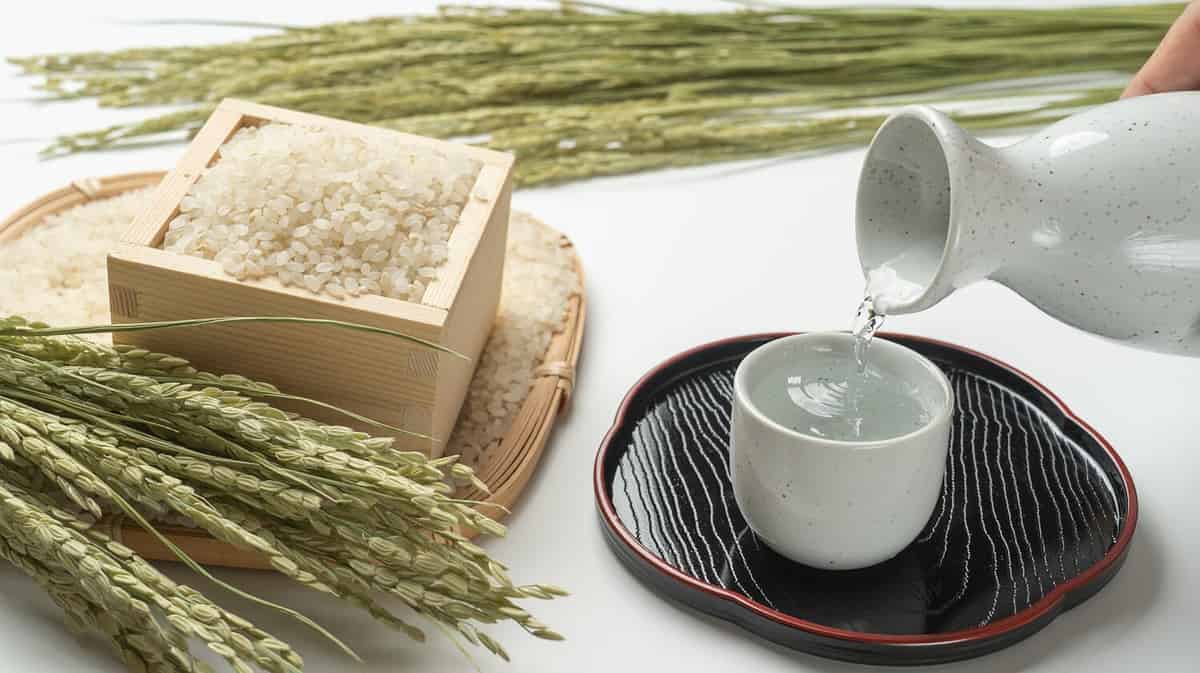
Rice wine, also known as Sake, is a sweet wine made from fermented rice.
©aomas/Shutterstock.com
What is Rice Wine?
If you’ve ever been to a Japanese restaurant, you might be familiar with Sake, which is a traditional alcoholic beverage in Japan. If you’re familiar with Sake, then you’re familiar with rice wine, since they’re usually describing the same beverage.
Rice wine is an alcoholic beverage you can make by fermenting rice. During the fermentation process, a combination of mold, yeast, and bacteria converts the starch into sugar. The sugar is then converted into alcohol.
While rice vinegar is only used for cooking, rice wine can be used for both cooking and drinking. There are many varieties of rice wine, especially in Asian countries. This sweet, alcoholic drink sometimes includes other flavors such as fruit or herbs.
Substitutes for Rice Wine
Despite the fact that they’re both made with rice, rice vinegar is not a substitute for rice wine. However, if you’re cooking with rice wine, there are several substitutes for you to use:
Pale Dry Sherry
Pale dry sherry is a great alternative to rice wine since the flavor is similar. While rice wine is more of a challenge to find, you can find pale dry sherry in most liquor stores. When substituting pale dry sherry for rice wine, you can use the same measurements.
Gin
Gin is another acceptable substitute for rice wine, especially when the recipe calls for white rice wine. Like pale dry sherry, it’s pretty easy to find gin at any liquor store. Gin is a distilled alcohol with a distinct pine flavor.
Dry White Wine
If you’re unable to find pale dry sherry or gin, a dry white wine would also work as a substitute. The flavor profile of dry white wine is different from that of a rice wine. However, if you’re using it in a recipe, you can always adjust your seasonings or ingredients.
White Grape Juice
When a recipe calls for rice wine, you might look for a non-alcoholic substitute. Rice wine is generally sweeter than other types of wine, so if you’re looking for something similar that doesn’t contain alcohol, white grape juice will do the trick.
Nutritional Values of Rice Vinegar vs Rice Wine
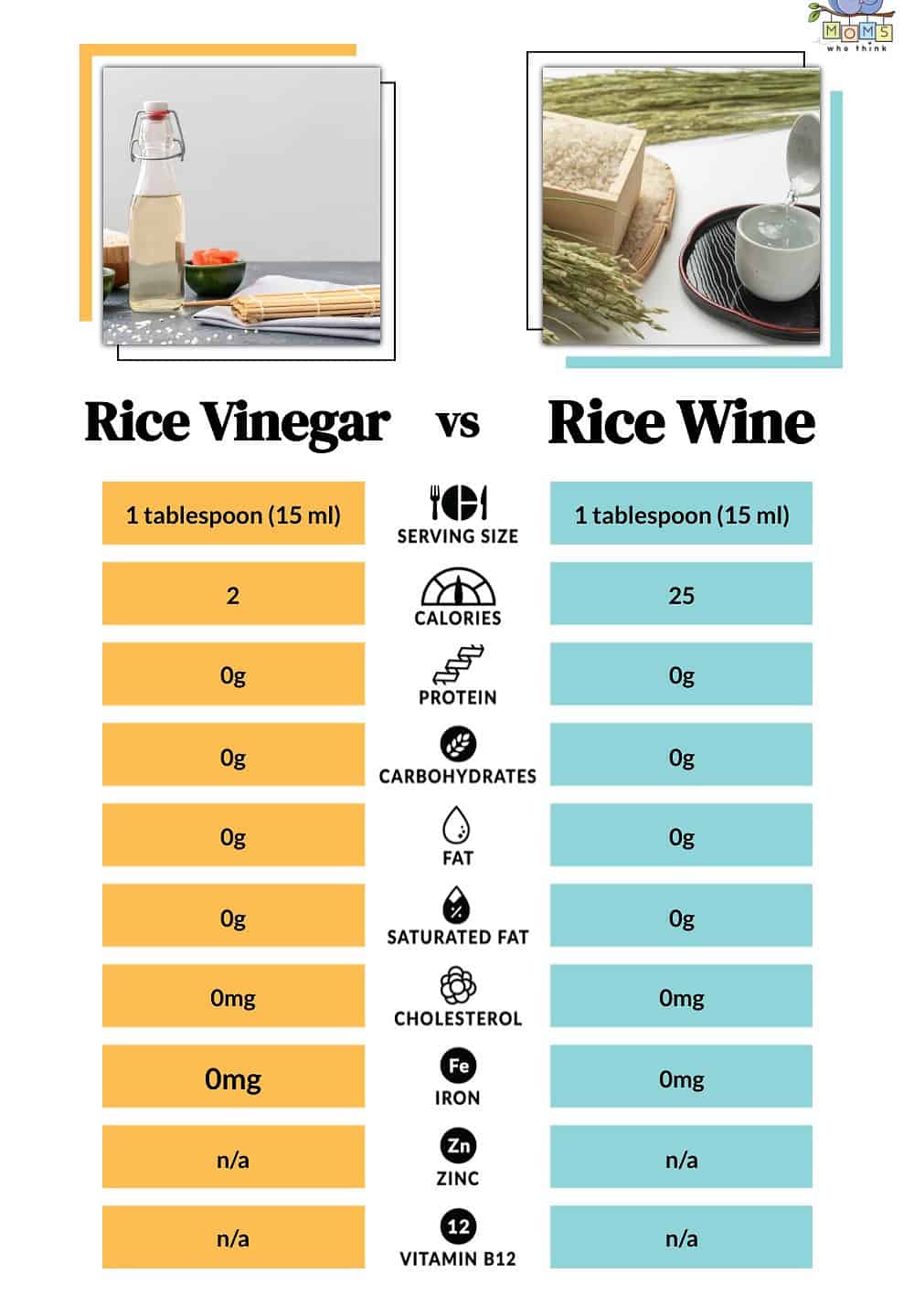
Can You Substitute Rice Vinegar for Rice Wine?
Rice wine and rice vinegar may sound similar, especially when rice vinegar is called rice wine vinegar, but they’re not the same thing. You can use both rice vinegar and rice wine for cooking, but rice wine is an alcoholic beverage while rice vinegar is a type of vinegar.
Even though vinegar is made from a fermentation process, there is very little, if any, alcohol left once the vinegar is complete. Considering the differences in their ingredients, rice vinegar isn’t a substitute for rice wine or vice versa. You’re better off using pale dry sherry for rice wine and apple cider vinegar for rice vinegar.
Choosing the Right Ingredients for Your Next Meal
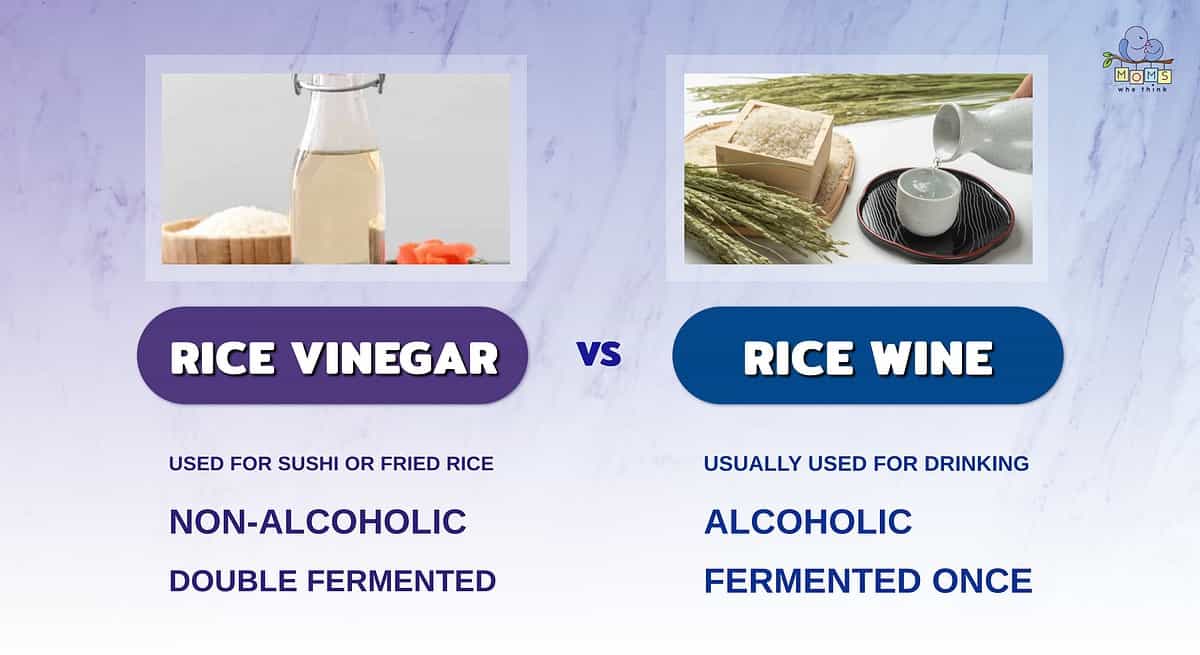
- Rice vinegar is typically used in food, while rice wine is usually used for drinking. Sometimes, rice wine is used in recipes.
- Rice vinegar is non-alcoholic, while rice wine is alcoholic. Rice vinegar may have trace amounts of alcohol left in it, but certainly not enough to be considered an alcoholic drink.
- The acidity of rice vinegar is due to the double fermentation process.
Whether you’re an experienced cook or new to certain types of cuisine, the number of options for ingredients can make cooking a challenge. This is especially true regarding different types of vinegar or wine. If you’ve decided to try your hand at making Asian cuisine, you may have wondered about the difference between rice vinegar vs. rice wine.
Although they can’t be used interchangeably, they are both great items to have on hand. Rice vinegar is a great addition to numerous recipes including stir-fry, marinades, and salad dressings. Even if you don’t need rice wine for your recipe, you might enjoy having a glass while you’re cooking in the kitchen.
Have some rice vinegar on hand? Give this recipe a try:
Print
Sesame Chicken with Broccoli
- Yield: Serves 4
Ingredients
5 tablespoons reduced-sodium soy sauce
4 teaspoons toasted sesame oil
5 teaspoons honey
1¼ pounds skinless, boneless chicken breasts, cut into 1-inch chunks
2 tablespoons canola oil
1 small head broccoli, cut into florets
2 scallions, thinly sliced, 2 tablespoons greens reserved
1 tablespoon grated fresh ginger
3 cloves garlic, minced
1 ½ cups low-sodium chicken broth
4 teaspoons cornstarch
1 tablespoon rice vinegar
1 teaspoon chili paste
3 tablespoons toasted sesame seeds
Cooked brown rice, for serving (optional)
Instructions
1. In a medium bowl, whisk together 3 tablespoons soy sauce, 2 teaspoons sesame oil, and 2 teaspoons honey.
2. Add the chicken, toss to coat, and marinate for 20 minutes.
3. Heat 2 teaspoons canola oil in a large nonstick skillet over medium-high heat.
4. Remove the chicken from the marinade with a slotted spoon and discard the marinade.
5. Add half of the chicken to the pan and cook until browned and cooked through, turning once or twice, about 6 minutes. Transfer the chicken to a large serving platter.
6. Repeat with 2 more teaspoons of canola oil and the remaining chicken. Transfer to the serving plate.
7. Add the broccoli to the pan along with 2 tablespoons water, cover and steam for 4 minutes.
8. Create a hole in the broccoli by pushing it aside and heat the remaining 2 teaspoons canola oil in the skillet over medium-high heat. Add the scallions, ginger, and garlic and cook, stirring until fragrant, 1 to 2 minutes.
9. In a small bowl, whisk together the broth, the remaining 2 tablespoons soy sauce, the remaining 3 teaspoons honey, the cornstarch, vinegar, and chili paste until the cornstarch and honey are dissolved. Add the mixture to the pan and cook, stirring, until the mixture is thickened and darkened in color, 2 to 3 minutes.
10. Stir in the remaining 2 teaspoons sesame oil.
11. Pour the sauce and broccoli mixture over the chicken. Sprinkle with the sesame seeds and 2 tablespoons scallion greens. Serve with brown rice, if desired.
Nutrition
- Serving Size: Per serving
- Calories: 410
- Sodium: 730mg
- Fat: 18g
- Saturated Fat: 3g
- Carbohydrates: 29g
- Fiber: 4g
- Protein: 36g
- Cholesterol: 90mg
